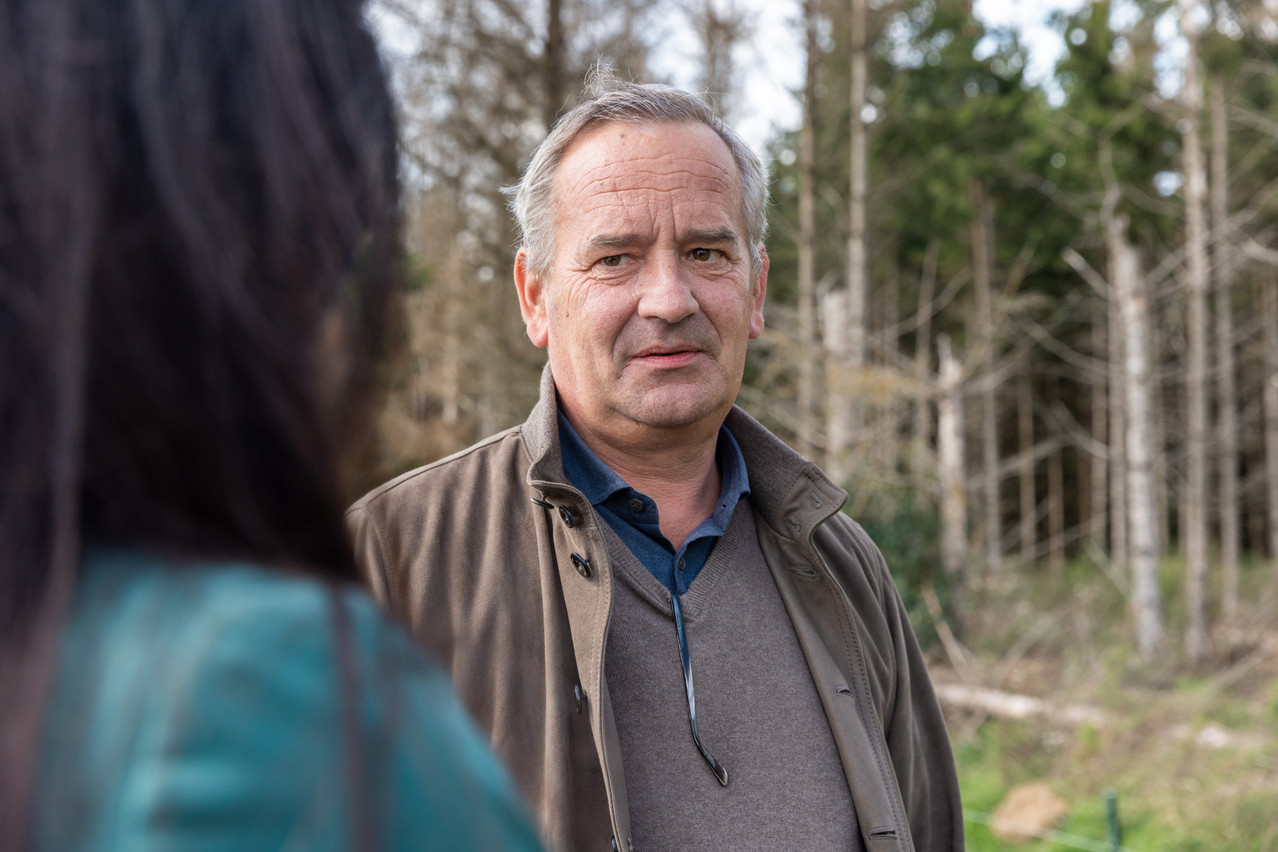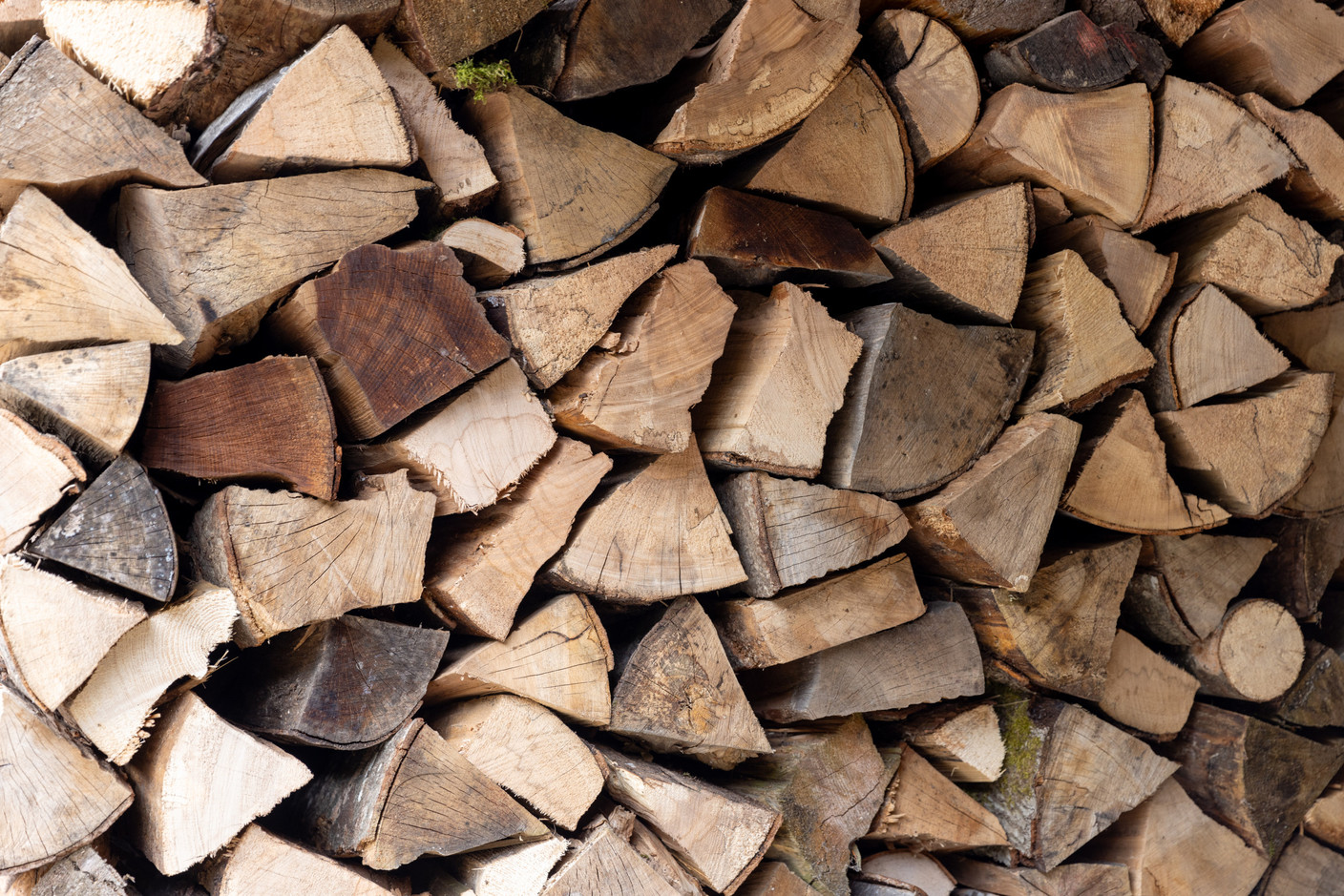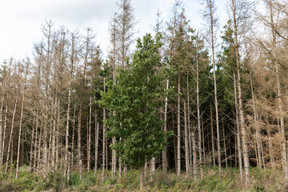Forests cover almost a third of Luxembourg’s territory. And as elsewhere, these natural spaces with their many virtues are facing major challenges, not least that of adapting to climate change, the scars of which are already clearly visible in the country’s woodlands. The president of Privatbësch, an association that aims to unite private forest owners, discusses these difficulties and some ideas for safeguarding this natural environment and its riches.
Maëlle Hamma: Forests cover 92,150 hectares, or around 35% of Luxembourg’s land area. How much of this is privately owned?
Hubert de Schorlemer: 52% of the plots are privately owned, which represents around 14,000 family companies or private individuals who maintain these forests. Within the association, there are around 2,200 members who own more or less half of this area. Private owners are not obliged to join. We have a fairly fragmented forest, with very small plots, ranging from less than half a hectare to fifteen hectares for the largest. These owners often look after the forest in addition to their work, on the weekends. Our role is to support them and help them make the right choices.
Who are these private owners and what activities do they carry out on their plots?
It really depends on each owner. Everyone has their own way of managing the land. Most have small plots, there are only four or five larger owners. Others live in Australia, Canada or elsewhere and are not on site. Often, it was the grandfather who managed the forest, and then the children inherited it. But not all of them farm it.
This year, we’ve noticed that some people have returned to their plots, in response to the energy crisis, to collect wood for heating. We’ve also noticed that there’s a bit of a movement, with young people taking an increasing interest in the forest, not only because of the energy crisis, but also because they’re very committed to biodiversity. This is a very good thing. In private forests, we have absolute freedom, we’re very open.
Climate change is not sparing Europe’s forests, even the most northerly. To what extent is this affecting Luxembourg forest owners?
Today, conifers suffer more from a lack of water. Some are attacked by small bugs that destroy the bark. However, from an economic point of view, spruce is very interesting, which is why everyone has planted them. In Luxembourg today, 61.7% of forest trees are seriously or severely damaged. It happens very quickly. Once a tree is damaged, it takes just three to four months for it to die.
How are the tree species distributed in local forests?
In the north, we find a majority of coniferous trees, while in the centre it’s more deciduous. The reason there are so many deciduous trees in the north is that the government wanted this after the Second World War. We needed to rebuild en masse and quickly, so wood like spruce was favoured. With a beech or oak (a hardwood), you have to wait 250 years before you can harvest the tree. For a spruce, it’s 60 or 70 years. But the spruce is the first to suffer from climate change, as it has very poor resistance to lack of water.
How long have you been observing this phenomenon here in Luxembourg?
I’d say five or six years, with the first droughts. Four of the last five years have been marked by severe drought.
What other problems are private owners facing?
Another problem we have here is that we have a lot of game and the hunters don’t shoot enough of it. We’re in discussions with them, but it’s not always easy. If game comes and eats a plant that is in full growth, it will remain a bush and will never be a good trunk. It won’t contribute anything in terms of production.
What’s important is to have at least 60% to 70% good quality trunks in a plot. If they’re of poor quality, you’re going to produce wood for the paper industry, which goes for €30 per m3, and that doesn’t add anything. What is interesting for an owner is to sell his wood to a joiner who will use it for parquet flooring, for example, at double the cost. There are also fire risks that do not go beyond Luxembourg, and there is a coordination group on this issue.
It’s not incompatible to have sustainable management while at the same time producing timber for the market and earning a bit of money.
What does sustainability mean for the forest?
It’s a concept coined by Carl Carlowitz, who said that you can’t cut more wood than the forest can produce. It’s a definition that’s even more topical today.
The forest is said to have three functions: economic, social and ecological. How do you strike the right balance between profitability and sustainability?
Yes, and it’s a balance that needs to be preserved. There’s the social aspect: everyone can go for a walk in the forest and it’s a source of well-being for humans, as many studies have shown. The economic aspect is also very important. Forests are a source of money, and without finance they cannot be managed. Finally, there is an important ecological aspect, because forests fix CO2 and play an essential role in water and air quality.
For example, 30 years ago, a study carried out for the City of New York showed that filtering water cost $12bn, whereas if we gave $2bn to forest owners for more sustainable management of their forests, the result would be the same. These three functions go hand in hand and must balance each other out. It’s not incompatible to have sustainable management while at the same time producing timber for the market and earning a bit of money.
What can they do to adapt to this change?
Today, we have to reinvent ourselves. I’m a forest owner myself, and I opt for natural regeneration. In other words, I don’t plant, I let seeds fall and the birds or the wind carry them away naturally. The result is a more varied forest, with several ‘floors’ and levels. This way, if a storm or disease strikes a tree, not everything is dead and the ground is still covered. When you have 10,000 to 15,000 plants on the ground, the soil can retain a certain amount of moisture. But when you plant the same trees, in rows, every two metres by two metres, the soil dries out more quickly.
So are regular forests, with rows of trees all of the same species, a thing of the past?
Yes. At the end of the day, it’s like with money: you can’t put all your eggs in one basket, so you have to vary the species. What’s more, a freely evolving forest harbours the same biodiversity as a sustainably managed forest. I’ve been to Bavaria, for example, to see what’s going on. There are families who have been managing forests from generation to generation since 1850. There are always three levels, the first 20 metres high, the second 40 metres high and the third 60 metres high. They only cut mature species. This is what we call sustainable management, and it’s also the most profitable method.
From an economic point of view, what happens to the wood produced in Luxembourg?
I’ve always been a bit critical of that, because our country is one-third forest, and the question is: what do we do with this wood? I often go to Scandinavia, where they produce wood-based petroleum for lorries, for example. To sell it here to a sawmill, you need two to three million m3 a year, otherwise it’s not profitable. But these are large volumes for a small owner.
So we sell our wood abroad, even though it’s the only renewable resource we have naturally in Luxembourg. For example, we sell our lower-quality beech to China to bring back parquet flooring.
To what extent will climate change affect yields in the future?
When the wood is affected by a small insect, the tree dies. A tree that dies is a complete loss for the owner who has looked after it for 20 to 30 years. It loses all its value. The owner has only one solution: cut it down. This completely dry wood no longer has any value, even for a simple fire. So yes, production is bound to fall. And this will affect more than just the owners. For example, if we change the type of species, and therefore the type of wood, sawmills will also have to change their machinery to anticipate. In Germany and Switzerland, some sawmills are already planning ahead.
When would the situation become critical?
I’d say in 30 or 40 years’ time. In the future, we may be able to use beech for construction, but at the moment we only know how to work it into strips that we then glue together. Today, you have to wait 25 years to make a profit, and tomorrow it will take much longer…
What support do you offer to owners in this situation?
As an association, and even more so in the context of climate change, we consult with them, we propose solutions, we set up panels with international experts to see what is being done elsewhere and what could be improved here. We also offer what we call the forest permit, which is a ten-session seminar for people who have no idea about the forest. We teach them about the ecosystem, its specific features, how to mark a tree, how to sell wood... For young people who have just inherited a plot of land, it’s an initial approach. Every year, around 50 people take part, including young people and women. We do an average of 300 to 500 consultations a year.
What is Letz reGenerate?
That’s our motto. It will be the theme of our anniversary day, because our priority is renewal. Renewal of our forests first and foremost, to adapt them to climate change, and also of our association by integrating new, young, next-generation owners. For us, this anniversary is an opportunity to raise the profile of the association, but also to position ourselves even more clearly as forestry experts. The anniversary celebration will be the starting point for a renewal.

The association will be celebrating its 90th anniversary at the Festsall A Mouschelt centre in Lintgen on 27 September, in the presence of its members and officials. Photo: Romain Gamba/Maison Moderne
You’re celebrating the association’s 90th anniversary on 27 September. What’s on the programme for this anniversary?
250 people will be here at the Festsall A Mouschelt in Lintgen, which has been made available to us by the mayor. We start in the early afternoon with everyone around the table. I want everyone to give their opinion and express themselves. I like to hear people talk, ask questions and get involved. There will then be expert panels on a number of subjects, such as the heritage of a forest, forestry responsibilities and which species should be favoured in the future. The day will end with a walking dinner, in the presence of the grand duke and a number of political leaders.
What do you think of the July forestry law?
It’s a good step forward. We are in contact and there are some good projects. But I think we can always go further... Generally speaking, the state’s support is good.
On 5 September, your association unveiled an analysis of the costs of protecting Luxembourg's forests in the face of climate change. What approach(es) did you use?
In an initial approach, we stipulated that a third of the trees that were clearly and severely damaged during the summer of 2022 will eventually die within the next ten years. For spruces, we doubled the figure to take into account the phenomenon of bark beetle, a particularly virulent parasite that is spreading exponentially as a result of rising temperatures.
In a second approach, we calculated the change in the proportion of severely damaged trees over the last four years alone and extrapolated this result over the next ten years, including the dying trees of 2022 and doubling the factor for spruce. We then determined the areas that could be regenerated naturally by excluding spruce and beech on warm slopes and clay soils. The remaining areas with dieback will then have to be planted with species better adapted to the new climatic conditions, such as sessile oak, wild cherry and other wild fruit trees, as well as lime and maple.
This initial analysis estimates the total cost of regenerating the forest at €750m. For one hectare, how many plants would be needed at what cost?
The cost of one hectare with 2,500 plants is estimated at €10,000 per hectare, including VAT, including site preparation, subsequent maintenance and reseeding. In conclusion, depending on the approach, the funding requirement over the next ten years will be almost identical, with an average total of €751.8m, including €247m for planting, site preparation, maintenance and reseeding, and €504.8m for measures to protect against game.
This article was first published in French on . It has been translated and edited for Delano.







